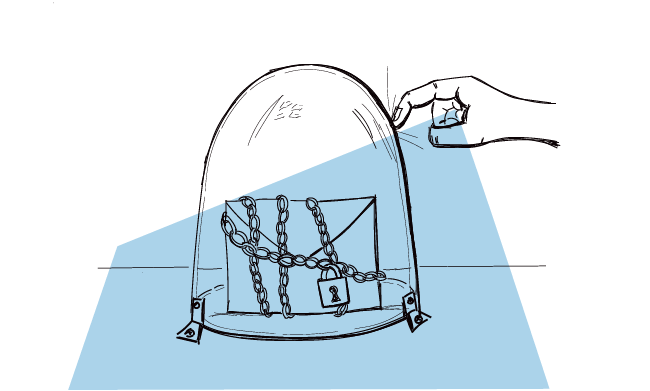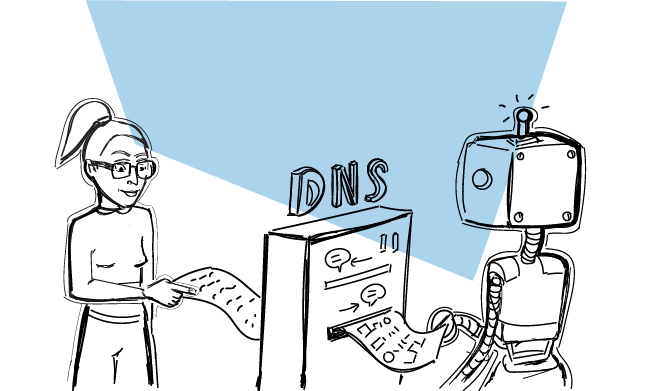Are you worried you won’t get what DNS is all about because you’re not a tech-savvy person? Well, neither am I. It’s for other people like me that I did my best to get to the bottom of this topic and explain it in plain English, as simply as possible.
So set your worries aside and dig in.
What is DNS?
DNS (Domain Name System) is a database that stores records for a domain (I’ll get to the records in a bit).
It’s most commonly used to translate domain names (that are easy to remember) into IP addresses (that are not).
Each device connected to the internet has an IP number. It uses it to communicate. I’m sure you’ve seen them, but IP addresses look something like this: 172.16.254.1. Or this: 2001:db8:0:1234:0:567:8:1. Imagine what a drag it would be if you had to remember the IPs! Thanks to DNS, though, you don’t have to: you can simply type in a domain name (e.g. woodpecker.co) and you’ll get the result – the site you were looking for.
DNS is basically like a dictionary translating from human-friendly to computer-friendly and the other way around.
That’s why you don’t have to wreck your brain and try to remember a long sequence of numbers every time you want to visit a website. All the server communication happens behind the scenes.
That’s not all that DNS is, though. It also holds a bunch of other important information about domains. As I mentioned, DNS is built of records. Some of them are: email authentication mechanisms (SPF, DKIM and DMARC records), email servers records (MX records), and TXT record verification of domain ownership.
What is DNS propagation?
It’s important that you remember that there is no one, universal DNS database.
When you make changes on your DNS server, it takes some time for them to take effect (aka, propagate) across the Internet.
You can check if your updates have already been propagated worldwide with tools such as this one or this one.
What DNS records are there?
Going back to DNS records – here are some of the most common ones:
A Record (Address Mapping record)
This is the address record. Most commonly used for linking hostnames (e.g. domains) with corresponding IPv4 addresses.
AAAA (IP version 6 Address record)
This is also an address record, but for IPv6 addresses. Its function is the same as an A Record.
CNAME (Canonical Name record)
CNAME aliases one hostname to another. What does it mean? It works similarly to an A Record, but instead of linking to an IP address, it links to another hostname.
MX (Mail Exchange record)
MX records are used to route outgoing emails to an email server. They specify an SMTP email server for a domain.
TXT (Text record)
These are machine-readable data that you add to your DNS. They may have various purposes, one of which is email security (the SPF, DKIM and DMARC records).
Read more about why you should set up SPF and DKIM and how to do it.
And why it’s also important to set up DMARC and how to do it.
How do you check your DNS records? And why would you even do that?
Well, if you have trouble accessing a service, you might need to check the status of corresponding DNS records.
Or you might want to verify the updates you made.
How can you check DNS records?
It’s simple – with a DNS lookup tool, like this one.
You may also check specific records. Just type your domain name in the search bar, and choose the record you want to look up. For example, “MX Lookup” or type in: “mx:yourdomain.com”.
You can check your DKIM, SPF and DMARC records this way as well.
While you’re at it, you might also check if your domain has been blacklisted – choose the “blacklist check” or type in “blacklist:yourdomain.com”
(If you’ve been blacklisted, no worries – see how to get your email server IP or domain off a blacklist.)
Over to you
DNS is a part of a complicated process that makes it easy for us to use the Internet – and email.
Hope this short guide helped you understand DNS a bit better!
READ ALSO

What is DKIM, SPF & DMARC? And How to Set Them Up
This is serious. This is about your email deliverability. I know from my own experience that these acronyms may sound unfamiliar, scary and may seem totally uninteresting. Or maybe they sound familiar, but you never cared enough to check what they really are. Either way, it's time to learn a bit about what SPF, DKIM and DMARC are and how to set them up in your DNS records for your mail server, if you want to have better control over your email deliverability.

DMARC: What Every Email Sender Should Know
Holy smokes, this one’s a tough one to crack. Or at least that’s what I thought when I first dug into DMARC. That’s why I went over to Wojtek, our Head of Deliverability here at Woodpecker, and asked him to explain it to me plain and simple. He helped me to understand what DMARC is exactly and why it matters.

SMTP & IMAP: What Is It? How Does It Work?
SMTP & IMAP are the two main protocols that allow you to send and receive emails. Why am I even writing about this? Well, sometimes we take crucial things for granted. We use them every day and don't ever think about how they work. I believe that this is one of such things. And I think that it's worth understanding how sending your emails works, especially if you send a lot of them as a part of your job.

